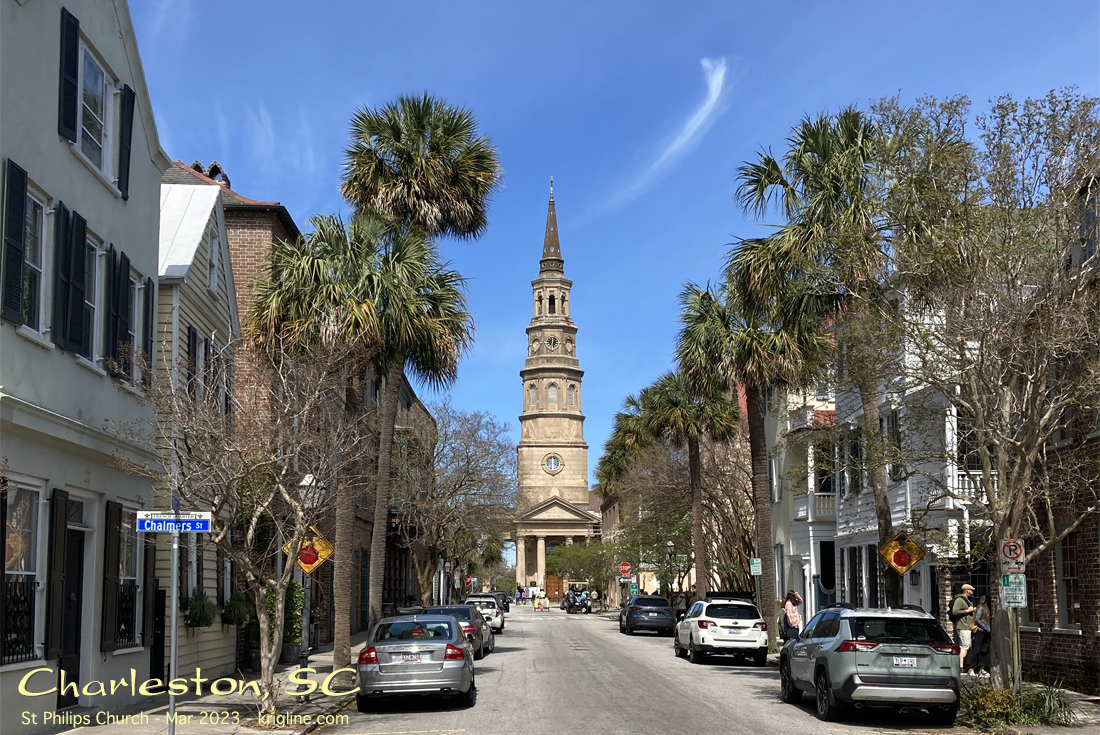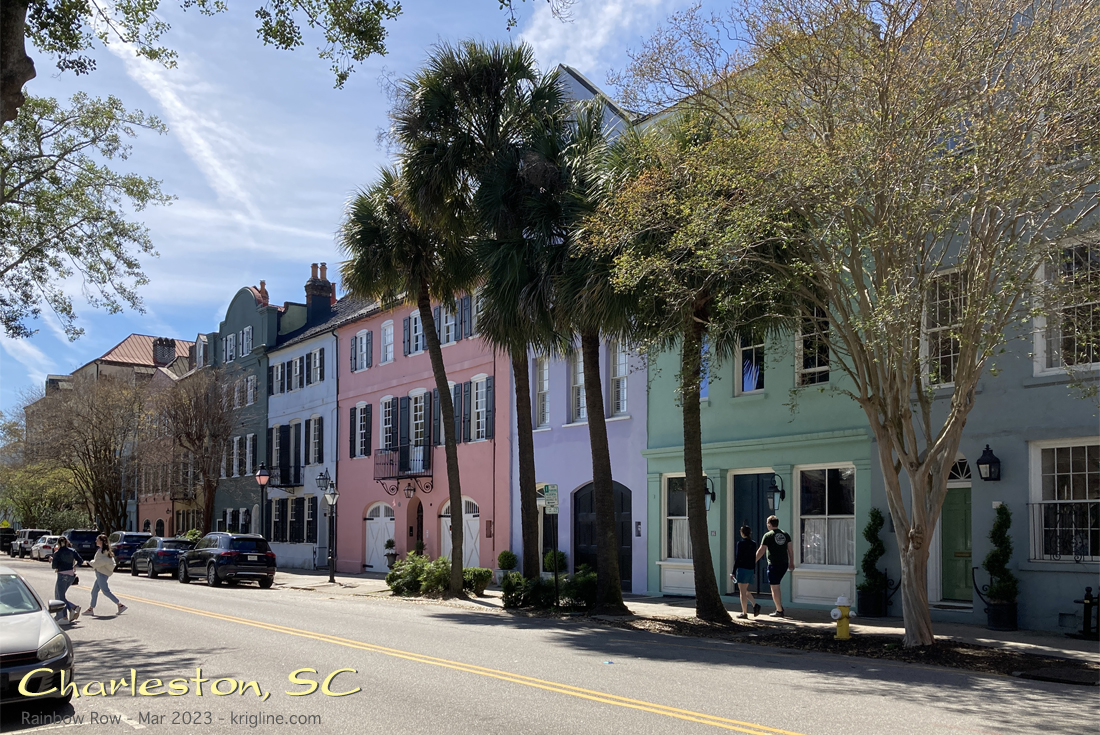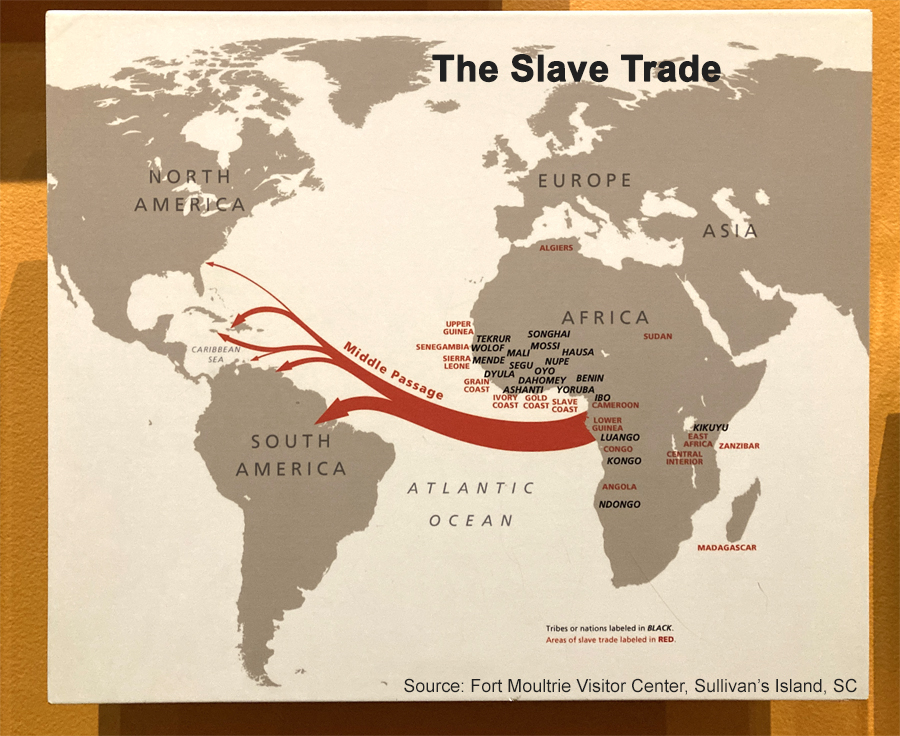Historic Charleston, a few seeds, and a teenage girl
How a persistent young woman in Colonial America made a lasting impact
March 2023. eflsuccess.com ⇔
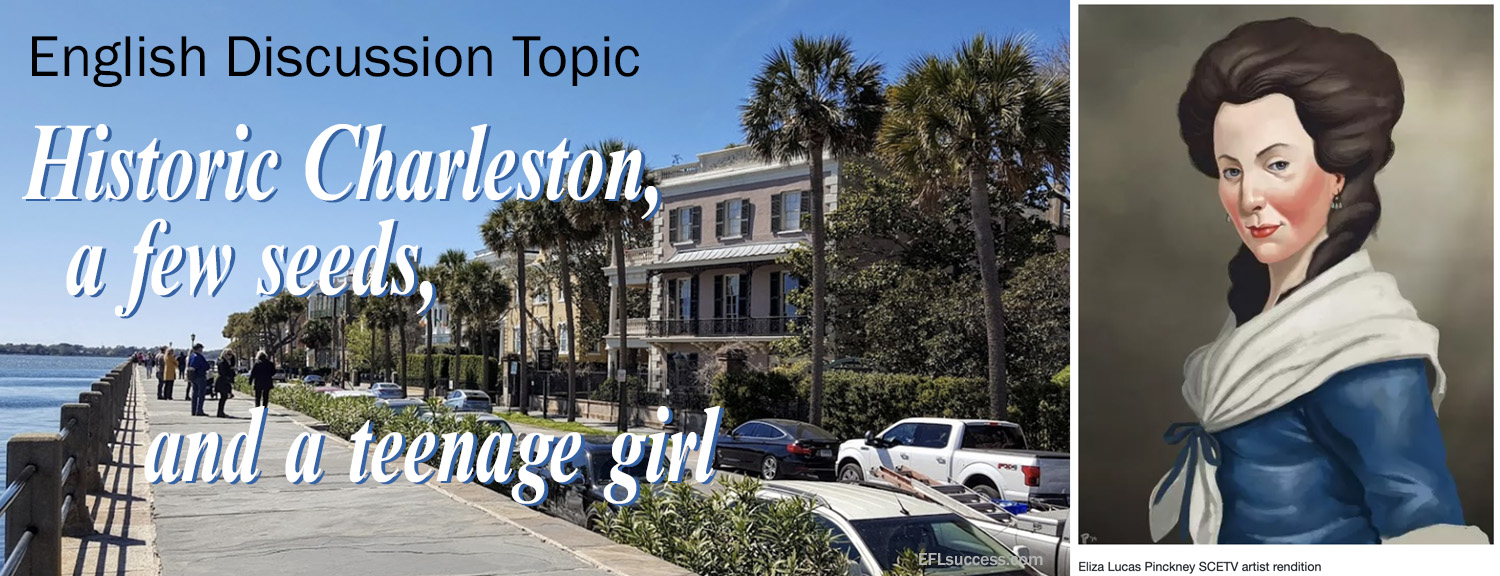
Underlined vocabulary terms are defined below, followed by discussion questions. You’ll also find a longer version of this article below.
Rice and Indigo
Charleston South Carolina’s early wealth and importance came from the export of two major crops: RICE and INDIGO (used to make the majestic blue dye seen on South Carolina’s flag).
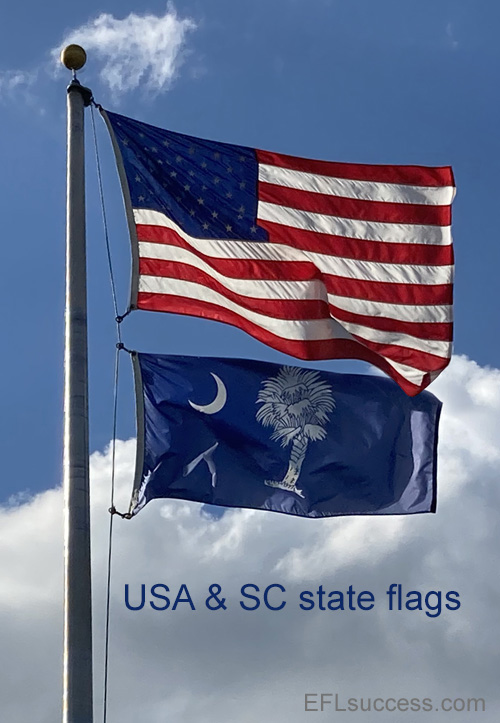
In 1739, Eliza Lucas (1722-1793) was a 16-year-old girl, who had just moved to the Charleston area after growing up in the Caribbean (her father was lieutenant governor of Antigua and owned several plantations in both places). Teenage Eliza loved botany and was determined to increase the wealth of the Lowcountry. She experimented with fruit and hard-wood trees. Then one day her father sent a letter with a few indigo seeds, suggesting that she experiment with this plant.
Like other planters, Eliza spent summers in Charleston to get away from swamp diseases. Neighbors ridiculed Eliza’s experiments, but her persistence paid off. In 1744, she managed to grow enough indigo to send a small sample of blue dye to Great Britain. That same year, she married widower Charles Pinkney; he was 45 and she was 22. By 1750 she and Charles had 3 children.
Their indigo business grew quickly (sadly, with the indispensable labor of hundreds of slaves). By 1747, 138,300 pounds of dye (worth £16,803) were exported to England, which welcomed the colonial alternative to French dye. (To put that in perspective, it was worth enough to buy 3600 cows!) Success continued up to America’s Revolutionary War. By 1775, about 30 years from Eliza’s experiments, over 1.1 million pounds of dye was sold, making up one third of SC’s exports. A teenage girl turned a few seeds into South Carolina’s second biggest crop!
Today, the indigo color is featured on South Carolina’s flag. Furthermore, Eliza’s first son, Charles Cotesworth Pinckney, was a signer of the US Constitution, 4-term SC governor, and SC political leader. One of the Pinckney’s plantations is now a National Historic Site, outside Charleston. Eliza Lucas Pinckney had a lasting impact on SC, and in 1989, Eliza was the first woman inducted into the SC Business Hall of Fame, for her contributions to agriculture.

St Philips Church on Church Street 
Rainbow Row (Charles C Pinckney lived here)
Vocabulary:
(underlined words are vocabulary terms; *key terms) [click here for common English abbreviations]
- *dye: a substance you use to change the color of fabric, clothes, hair, etc.
- botany: the scientific study of plants
- plantation: a large area of land, normally used to grow tea, rice, cotton, rubber, etc.
- *to ridicule: (negative) to laugh at a person, idea, etc., and say that they are stupid
- *persistence: determination through difficulty; the drive to not give up, in spite of problems or set backs
- *managed to (do sth): an informal way to say that you did something that was not easy to do (“It is a rare medicine, but I’ve managed to find some.”)
- widow/widower: someone whose spouse has died and who has not remarried (widow is a female; widower is a male)
- *inducted: to officially introduce someone into an important group or organization (e.g., an honorary society, the army, etc). [That’s the most common AmE definition; in BrE it can indicate an honorary introduction or an official way to grant sb a position of authority.]
Discussion:
Are there any terms you want to ask your teacher about? (As always, please do not answer any question that makes you uncomfortable.)
- Have you ever felt down when facing a challenge with few resources? How do you think Eliza felt when she opened her father’s letter and saw a handful of seeds?
- Eliza overcame many difficulties: (1) very difficult travel by ship, (2) a father who was working abroad, (3) getting an education as a girl, (4) ridicule from neighbors, (5) early marriage, (6) death of a son in 1747, (7) distance to markets in England. How do you think she overcame these challenges?
- If you were 22, would you marry someone who is 45? Why or why not?
- What special problems do you think Eliza faced as a female in the 1700s?
- When some people face a big challenge, they get depressed and do nothing; others are hopeful and get to work. What do you think is the difference between these responses?
- Many people helped Eliza (father and his money/connections in England, teachers/books, mother & sister, Charles, slaves, even int’l politics…). Tell us about some of the people and resources you are grateful for.
- If you are willing, talk about a challenge you have faced, and how you overcame it. (Or talk about a current challenge and ask classmates for suggestions!)
If you have extra time, discuss this passage from the Bible:
Consider it pure joy, my brothers and sisters, whenever you face trials of many kinds, because you know that the testing of your faith produces perseverance. Let perseverance finish its work so that you may be mature and complete, not lacking anything. If any of you lacks wisdom, you should ask God, who gives generously to all without finding fault, and it will be given to you. (James 1:2-5 NIV) Do you want to be persevering, mature and complete? If so, what kind of experiences or education do you think can make you that way? Have “trials of many kinds” ever turned out to be a good thing? If so, talk about it.
Sources include
https://www.nps.gov/chpi/learn/historyculture/eliza-lucas-pinckney.htm (also source of the picture of Eliza)
https://www.nps.gov/chpi/learn/historyculture/index.htm
https://charleston.com/charleston-insider/lowcountry-lifestyles/the-captivating-history-of-rainbow-row
https://youtu.be/26b9GKYfoJY
(Pinkney slaves) https://www.postandcourier.com/news/lost-lives-of-african-americans-to-be-featured-in-sc-historic-plantation-sites-redesign/article_0f21b5f8-57dd-11ea-a15a-cf3dd01c39a8.html
For higher English level
Some vocabulary terms are defined above; you can also use the above discussion questions.
Historic Charleston, a few seeds, and a teenage girl
(an early American success story) Michael Krigline 2023 EFLsuccess.com
In the late 1600s and early 1700s, Charleston South Carolina’s colonial wealth and importance came from the export of two major crops. One of the early city-fathers figured out how to grow rice despite the brackish water, and this became the #1 export. The other crop that made Charleston really wealthy was indigo, used to make the majestic blue dye seen on South Carolina’s flag.

In 1739, Eliza Lucas (1722-1793) was a 16-year-old girl, who had just moved to the Charleston area after growing up in Antigua (an island in the Caribbean, of which her father was lieutenant governor). Her mother and sister were with her. The family owned several plantations in Antigua and in the SC Lowcountry. Eliza loved botany and education in general. She was determined to increase the wealth of the Lowcountry, which had only one cash crop (rice). She experimented with fig and other fruit trees and even oak trees (foreseeing the need to build great ships).
She ended up in charge of her father’s three SC plantations, thanks in part to a couple of wars. From the Caribbean, her father sent his daughter a letter with indigo seeds in it, suggesting that she figure out what to do with these plants. Neighbors ridiculed Eliza’s experiments, but years of persistence paid off. In 1744, she managed to grow enough indigo to begin the process of dye production. With help from her father, a small sample of indigo dye reached Great Britain.
To get away from the mosquitos and their diseases in the summer, it was customary that planters of Eliza’s status would socialize in Charleston during the summer. There, she became close to the Pinckney family, especially after her father had become governor of Antigua. Eliza Lamb Pinckney became a close friend, but her husband Charles Pinckney was very skeptical of Eliza’s interest in planting. He wrote “Tell the little visionary come to town and partake of some of the amusements suitable to her time of life.” Young Eliza responded “Pray tell him…what he may now think whims and projects may turn out well by and by. Out of many surely one may hit.”
Of course, Eliza’s success was only possible because of the hard work of many, many enslaved people, working in the hot Carolina (and hotter Antigua) sunshine. Unlike Eliza, they didn’t get a summer break from “the mosquitos and their diseases,” nor did their fortunes increase with the success of their crops. While it’s uncertain how many slaves the Pinkneys owned, records show that Charles C Pinckney (a generation later) held around 250 slaves on one 715 acre plantation—and his mother Eliza ran three plantations. Slavery is one of the dark parts of world history, and sadly, it continues in vast numbers to this day. The contributions of America’s slaves are now being told in many of our textbooks, museums and National Parks (including several in Charleston)—but we can never expunge the scars of man’s inhumanity to man. [For more about slavery, see the “sources” list, my article on Juneteeth, or my photo page about Charleston.]
In 1744, the same year she first sent dye to England, two tragedies struck. First, Eliza’s father asked the family to return to Antigua, and second, her dear friend Eliza L Pinckney died, leaving Charles a widow. Charles proposed to young Eliza; he was 45 and she was 22. The marriage saved her from returning to Antigua, and by 1750 she and Charles had 4 children (though their second son died young, in 1747).
Their indigo business grew quickly. By 1747, 138,300 pounds of dye (worth £16,803) were exported to England, which was happy to have a way to cut out the French (long-time political enemies) from dominating the market. (To put that amount in perspective, it was worth enough to buy 3600 cows or 560 years of skilled labor!) By 1775 (when the Revolutionary War started), 1,122,200 pounds of dye was sold, mostly in England (with a small percentage being shipped to northern colonies). At that point, about 30 years from Eliza’s first experiments, indigo made up one third of the exports from South Carolina. A teenage girl turned a few seeds into South Carolina’s second biggest crop!
Today, the indigo color is featured on South Carolina’s flag. Furthermore, Eliza’s first son, Charles Cotesworth Pinckney, signed and contributed to the US Constitution, was a four-term SC governor and SC political leader for over 40 years. You can visit one of the Pinckney’s plantations, which is now a National Historic Site outside Charleston. Eliza Lucas Pinckney had a lasting impact on SC, and in 1989, Eliza was the first woman inducted into the SC Business Hall of Fame, for her contributions to agriculture.
PS: Eliza’s first son, Charles Cotesworth Pinckney, signer of the US Constitution, is one of three Founding Fathers buried in Charleston; he is buried in St Michael’s churchyard. Charles owned #95 Rainbow Row in 1779 (before the Row was painted in pastel colors).
See sources above
EFLsuccess.com; ©Michael Krigline, all rights reserved. This resource was created for our students under my understanding of “fair use” for educational resources. As far as I am concerned, people are allowed to print/copy it for personal or classroom use. See our Website Standards and Use Policy.
~ ~ ~ ~ ~ ~ advertisement ~ ~ ~ ~ ~ ~

